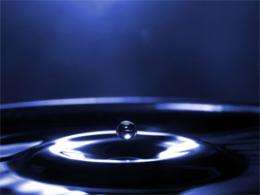Uninhabited water: Where no microbe has gone before

(PhysOrg.com) -- NASA's 'follow the water' strategy to find life on other planets might need rethinking, according to Australian National University research describing the amount of water on Earth that doesn't support life.
In an effort to find the limits of terrestrial life, ANU PhD student Eriita Jones and Dr Charles Lineweaver from the ANU Planetary Science Institute have mapped out the ‘uninhabited’ water on Earth.
The researchers say that life on Earth is constrained to live in a thin shell that amounts to less than 1 per cent of the volume of the planet. Yet roughly 3.5 per cent of the volume of the Earth can have liquid water in it.
“Our initial goal was to locate regions on Mars where the temperatures and pressures are suitable for life, but we soon realized that since we know a lot more about the Earth we should look here first,” Ms Jones said. “Our initial expectation was that we would find all liquid water on Earth to be inhabited. We were surprised to find that this wasn’t the case.”
The researchers compared the extent of liquid water environments on Earth with the environments inhabited by terrestrial life in order to locate ‘uninhabited’ water. Although all terrestrial life requires liquid water during some phase of its life cycle, the researchers found not just any water will do. Some water is too hot or too cold or too salty or too poor in nutrients to support life.
“We compiled global temperature and pressure limits to get a comprehensive view of the environmental limits of terrestrial life,” Ms Jones said. “We mapped out all possible environments on Earth where there is water and all the environments in which life is known to exist. We found that roughly 1 per cent of the water on Earth is ‘uninhabited’, but that 1 per cent is incredibly spread out in the crust and upper mantle. This means that 88 per cent of the volume of the Earth where there is some liquid water is uninhabited.”
Dr Lineweaver said: “Even after roughly four billion years of evolution, life on Earth has not been able to figure out how to live in some water on this planet. The fundamental limits that we have identified may be more than just limits on terrestrial life - they may apply to any terrestrial-like life in the universe.”
The researchers’ paper To What Extent Does Terrestrial Life “Follow the Water”? is being published this week in the journal Astrobiology. A proceedings paper, Pressure-temperature phase diagram of the Earth, provides more information.
More information: Both papers are available at www.mso.anu.edu.au/~charley/publications.html
Provided by Australian National University


















